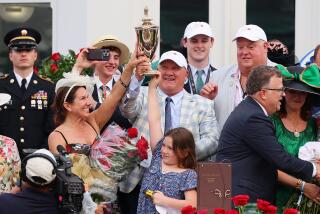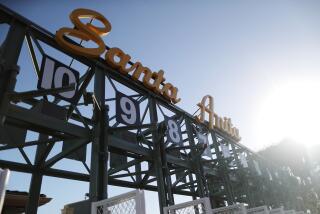A Tradition Lives On at Santa Anita
- Share via
In 1935, when they ran the first $100,000 Santa Anita Handicap, it was not only an audacious idea, it was almost the only game in town.
Los Angeles was widely considered a cultural wasteland at the time where they--ugh!--made movies of people hitting each other with pies. It was just a place where people went to die, or to enroll in some kind of kookie religion. America’s psychiatric wing.
It wasn’t even bush league. Dubuque, Iowa, was bush league. Los Angeles was even lower than that. It was a non-place. The Rams wouldn’t be along for a decade, the Dodgers for more than two. The USC Trojans--and Shirley Temple--were the only big-league attractions the area had.
The Kentucky Derby purse was $40,000 that year. The country was in the grip of the Great Depression. Bread was a nickel. Cigarettes were 9 cents. Trouble was, nobody had 9 cents.
So, a $100,000 race was an aberration. What you might expect of the kind of people who inhabited Southern California. People who didn’t know the value of a dollar. Or much of anything else.
New York was so sure it was dealing with types who believed in fairies that it shipped its top horses out by the boxcar to get in on this temporary insanity before common sense set in. If it ever did in California.
Well, Ladysman, Time Supply, Mate, Equipoise, Twenty Grand and Top Row all trained in to get some of that sucker money before the promoters tapped out.
It wasn’t the first time the East had seriously underestimated California. The invaders all went home in a barrel. The mighty Equipoise finished seventh. Twenty Grand couldn’t even do that. He got 10th.
The winner was a foreign-bred. Azucar. That set a precedent with which Santa Anita was to become familiar. Within four years, Kayak II, an Argentine-bred won the big race and in succeeding years, Olhaverry from Chile, and Talon from Argentina, won. In 1952, the South American gray, Miche, won but was disqualified, and Intent was declared the winner.
The Irish-bred Noor beat the mighty Citation in 1950, and the foreigner, Poona II, scored in 1955. The Chilean-bred Cougar II won in 1973. Santa Anita was kinder to immigrants than Ellis Island.
More than 34,000 people showed up for the first Santa Anita Handicap. They bet $802,553. Racing was stunned. So was everyone else. Coast-to-coast radio, attracted by the fairy-tale purse, had broadcast the race in prime time.
That was 50 years ago. Racing boomed after that--but it hasn’t boomed lately. Lately, racing was supposed to be the sick man of sport. Declining attendance, plummeting mutuel handles and precipitate retirement to stud of its stars conspired to make the sport of kings as anachronistic as kings generally. They had to hand out tote bags, T-shirts, wristwatches and free glasses to get anybody to come, to keep the windows open.
Until Sunday. On Sunday, 85,527 bettors showed up at Santa Anita. They chunked in $12,611,415 on the nine-race card. That was only the largest crowd ever to see a non-Kentucky Derby race in the history of the sport. The amount bet was only the most ever. Not even the Kentucky Derby, which has two-day wagering, could match it.
What happened? No one is quite sure.
There was an attraction of sorts in the No. 6 horse, a great, flop-footed goof of a colt who goes on the track masked and hooded like a guy on his way to burn a cross. Not that that endears him to anybody, but Gate Dancer is as unpredictable as boarding-house stew, and he ran about as expected--an indifferent third.
The race turned the clock back in another respect: It was won by a horse from South America. And it was ridden by a rider who has ridden so many thousands of horses at Santa Anita so well that it is freely predicted that Bill Shoemaker will some day go to his final reward on the back of a 2-to-1 shot in the backstretch at Santa Anita and will still win the race because he will be able to hold a horse together even after he is no longer able to hold himself together.
The winner was a nice big-butted old sort who used to scatter the competition at the Hipodromo and San Isidro tracks in Buenos Aires, where he ran 1:35-flat miles and better. He has never been worse than third in this country.
Lord at War picked up right where Azucar started, showing his heels to the pride of Kentucky in the big handicap. In fact, had he faltered, Greinton, who did his best racing at St. Cloud and Longchamps near Paris, would have been still another overseas winner.
Lord at War is owned by the old eight-goal polo player, Peter Perkins, and his wife, Dianne, who divide their horse-breeding business equally between Kentucky and Argentina. “It is a great place to raise horses,” says Perkins of the Argentine. “Some of the best runners in the world come from there.”
One of them was Lord at War, who had showed such rippling speed in the Pampas that the Perkinses tried to get him into the Arlington Million race in Illinois last year. He was turned down, probably because rivals got a clock on him in time there.
He won $275,600 for the Perkinses Sunday. On balance, that’s not as much as the $108,400 Azucar won in 1935. In 1935, $108,400 would have bought you some small countries.
But the central facts are, the world hasn’t changed as much as we thought it had, the 50th anniversary of Santa Anita’s revolutionary handicap was quite as successful as the original, and there may well be a 100th. If so, it will deal with another Santa Anita--and American--tradition, and the money will be made once again by a horse who wasn’t born here.
More to Read
Go beyond the scoreboard
Get the latest on L.A.'s teams in the daily Sports Report newsletter.
You may occasionally receive promotional content from the Los Angeles Times.










